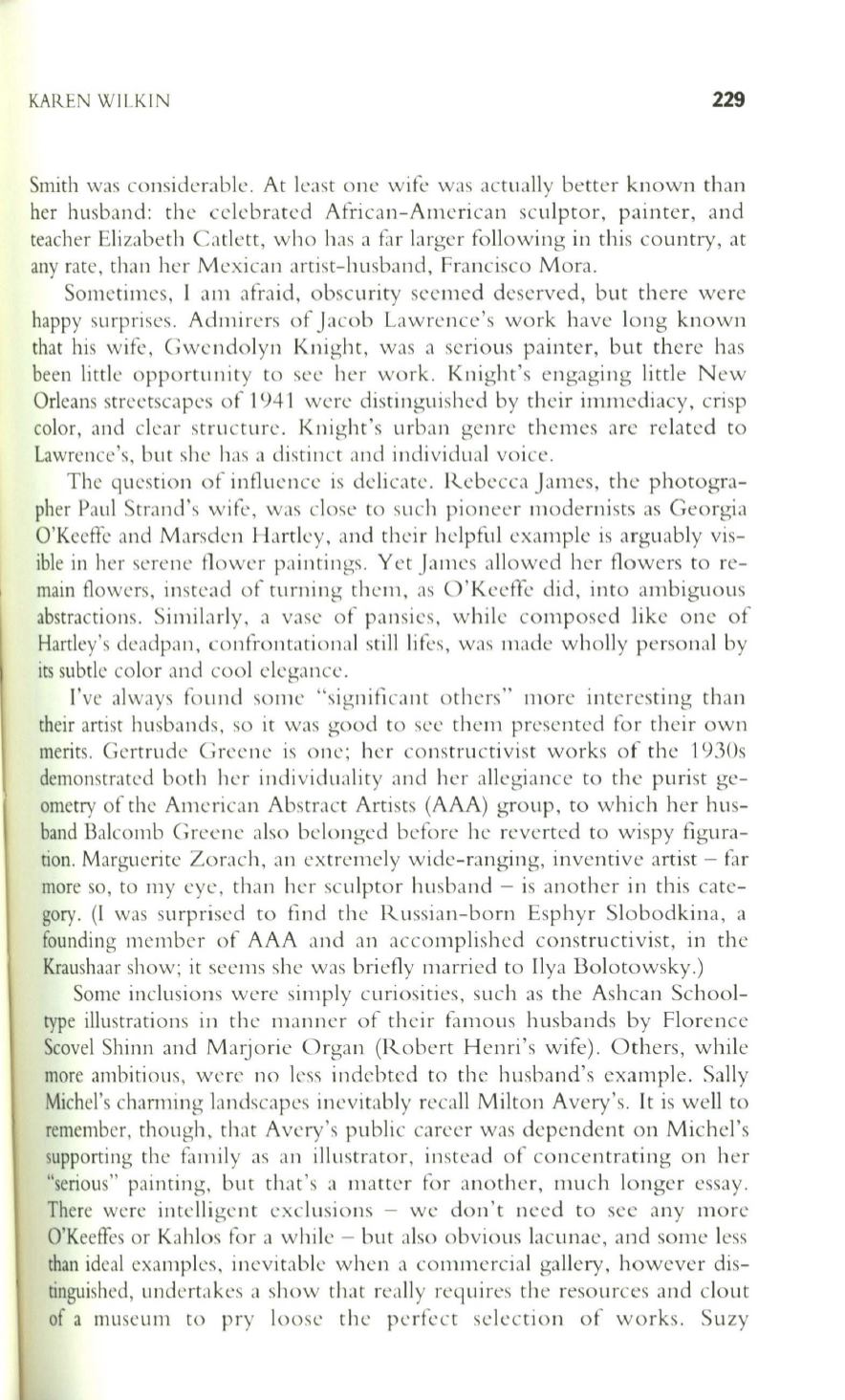
KAIliN WILKIN
229
Smith was considerable. At least one wife was actually better known than
her husband: the celebrated African-American sculptor, painter, and
teacher Elizabeth Catlett, who has a far larger following in this country, at
any rate, than her Mexican artist-husband, Francisco Mora.
Sometimes, I am afraid, obscurity eemed deserved, but there were
happy surprises. Admirers of Jacob Lawrence's work have long known
that his wife, Gwendolyn Knight, was a serious painter, but there has
been little opportunity to see her work. Knight's engagin g little New
Orleans streetscapes of 1941 were distinguished by their immediacy, crisp
color, and clear structure. Knight's urban genre themes are related to
Lawrence's, but she has a distinct and individual voice.
The question of influence is delicate. Rebecca James, the photogra–
pher Paul Strand's wife, was close to such pioneer modernists as Georgia
O'Keeffe and Marsden Hartley, and their helpful example is arguably vis–
ible in her serene flower paintings. Yet James all owed her flowers to re–
main flowers, instead of turning them, as O'KeefT'e did, into amb iguous
abstractions. Similarly, a vase of pansies, whi le composed like one of
Hartley's deadpan, confrontational sti ll Iifes, was made wholly personal by
its subtle color and cool elegance.
I've always found some "significant others" more interesting than
their artist husbands, so it was good to see them presented for their own
merits. Gertrude Greene is one; her constructivist works of the 1930s
demonstrated both her individuality and her allegiance to the purist ge–
ometry of the American Abstract Artists (AAA) group, to which her hus–
band Balcomb Greene also belonged before he reverted to wispy figura–
tion. Marguerite Zorach, an extremely wide-ranging, inventive artist - far
more so, to my eye , than her sculptor husband - is another in this cate–
gory. (I was surprised to find the Russian-born Esphyr Siobodkina, a
founding member of AAA and an accomplished constructivist, in the
Kraushaar show; it seems she was briefly married to I1 ya Bolotowsky.)
Some inclusions were simply curiosities, such as the Ashcan School–
type illustrations in the manner of their famous husbands by Florence
Scovel Shinn and Marjorie Organ (Robert Henri's wife). Others, while
more ambitious, were no less indebted to the husband's example. Sally
Michel's charming landscapes inevitably recall Milton Avery's.
It
is well to
remember, though, that Avery's public career was dependent on Michel's
supporting the family as an illustrator , instead of concentrating on her
"serious" painting, but that's a matter for another, much longer essay.
There were intelligent exclusions - we don't need to see any more
O'Keeffes or Kahlos for a while - but also obvious lacunae, and some less
than ideal examples, inevitable when a commercial gall ery, however dis–
tinguished, undertakes a show that really requires the resources and clout
of a museum to pry loose the perfect selection of works. Suzy


